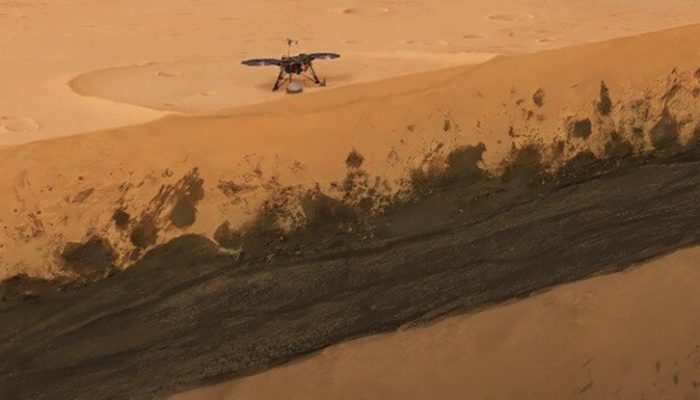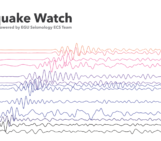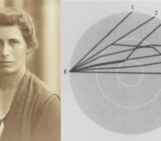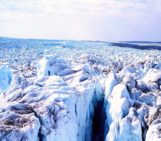
This week we interview Géraldine Zenhäusern, a PhD student at ETH Zurich’s Department of Earth Sciences, about her experience of being on the frontline of spotting Marsquakes with NASA’s InSight mission….
What is the InSight mission?
The NASA InSight (Interior Exploration using Seismic Investigations, Geodesy and Heat Transport) mission is a geophysical observatory (see Fig. 1) which landed on Mars in November 2018 and has been collecting data since then. There are different instruments on the lander and on the ground: wind and pressure sensors, several temperature sensors, a heat flow probe (which sadly failed to burrow into the ground), radio antennas to track the wobble of Mars’ spin axis, and of course the SEIS instrument. SEIS has two seismometers, the Very Broadband (VBB) and the Short Period (SP). Unlike the Viking mission which had its seismometer on deck, SEIS has been deployed to the ground and is covered by a wind and thermal shield. This helps us minimize the effect of the martian wind and extreme temperature differences (often more than 80K during one day) while we hunt for marsquakes.
Why is it important to look for quakes on Mars?
Quakes tell us a lot about what is happening inside a planet (or moon). On Earth, plate tectonics drive a lot of seismic activity. There is noise due to oceans, human activity, wind hitting trees and more. This is of course different on Mars, which has only a single plate and different noise. What drives seismicity if not plate tectonics? Spoiler: some is probably volcanism. Further, we can use seismic phases to learn more about the structure and composition of the interior. Mars has a prominent planetary dichotomy with highlands in the southern hemisphere and lowlands in the north. The planet is also a lot smaller than Earth (3389 km radius), so the internal structure is affected by that as well.
We see different types of quakes which vary quite a bit in frequency content, duration, location etc, so they probably have different sources and propagation paths. The initial analysis, phase picking, cataloguing, magnitude estimation, and event location is done by the Marsquake Service (MQS) and summarized in the MQS catalogue.
What does the Marsquake Service do?
We are a small group of seismologists on a duty roster who take turns analysing and cataloguing the seismic data arriving from InSight. There is always one person on frontline duty and one person on backup. We get a notification when the data arrive on our server (after going through the NASA Deep Space Network and processing at the French space agency CNES) and the person on duty analyses the data the same day, often within a few hours after arrival. If there is anything unusual, the person on backup is the first contact point. If a marsquake is special, e.g. large amplitude, good quality signal or anything like it, we call for an urgent meeting in a wider ‘review team’. There, we pick all seismic phases that we can see, try to determine a location with a distance and back azimuth and discuss the event in more detail. The whole InSight Science Team is then informed by mail and the event is presented to everyone in detail during another meeting. Every 3 months, the data are released to the public with a 3 month delay accompanied by the MQS catalogue.

Figure 1: This illustration shows NASA’s InSight spacecraft with its instruments deployed on the Martian surface. Image credit: NASA/JPL-Caltech.
How do the data look?
Mars is very quiet compared to Earth (no oceanic microseism), but marsquakes are also much weaker and we only have a single station. Often the quakes are even below a nanometre scale – our seismometers are very sensitive! Besides the marsquakes, the seismometer also records the local atmospheric conditions. There is a lot of wind during the day which means we can only see the strongest quakes over the noise. After sunset, the wind dies down and we can record very small quakes. There is also a seasonal wind variability – during Martian fall and winter, it is windy all the time and we can see almost no quakes at all. There are also some peculiarities: the lander itself is shaking in the wind and we see that as wind-excited (and temperature sensitive) lander modes at different distinct frequencies. When the noise is low, we see a resonance at 2.4 Hz. This resonance, and whether it is coming from the lander itself or a subsurface structure (or both?), is one of the most heavily discussed and disputed topics in the science team! It is excited by marsquakes and therefore features heavily in the marsquake analysis.
And the marsquakes?
To date, we have over 1300 categorized marsquakes. MQS has divided them into two broad families by their frequency content: low frequency, and high frequency. They are separated by the 2.4 Hz resonance. So if the main energy is at or above 2.4 Hz, it is a high frequency family event. These families are further divided into sub-categories, all with some special characteristics by which we categorize them. One category has more horizontal than vertical energy, for example.
Low frequency events are ‘classical’ tectonic events. We have located several of them east of InSight at Cerberus Fossae, an extensional graben system with possible dyke-induced seismicity. Sadly, we often only have a distance for an event and cannot find the direction where the energy is coming from, which makes locating it impossible. Some high frequency events might by related to the graben flanks of Cerberus Fossae (Stähler et al., 2022).
We also have a special class called Super High Frequency events. They have (as the name suggests) a high frequency content between 5 and 30 Hz and are very short in duration (20 seconds). These are associated with thermal cracking close to the lander, something that was also seen with seismic data from the Apollo missions on the Moon.

Figure 2: Vertical velocity waveforms of seismic events S1094b (top) and S1222a (bottom). S1094b is a confirmed impact with a 150 m crater. S1222a is the largest marsquake in the InSight mission so far.
What are some of the highlights of frontline duty?
I was the lucky person on duty for the two most distant events (S0976a and S1000a). The second one even occurred on the 1000th Martian day after landing! They are the only two events that we have from the other side of the planet and were the largest magnitude quakes for a long time. In May 2022 we had an even bigger quake with MW 4.7, but much closer to the lander (see Fig. 2). As frontline, you are the first person to look at seismic data from another planet, which never ceases to be exciting! I joined MQS frontline at the end of the first year of observations and we thought we had marsquakes figured out. Then, Mars threw us all kinds of curveballs in the second year with far away events, several small and large impacts, events appearing to come from unexpected directions, or signals which just looked weird and different from what we were used to.
What’s the future of the project?
InSight is powered by solar panels, which by now are covered by a lot of (very sticky!) dust (Fig. 3). Sadly, the mission ended in December 2022 after the lander dropped below the minimum required power level to continue operations and shut down. The rich data we have collected during the mission will continue to be analysed of course! There are still many mysteries in there which we hope to uncover. The data is available on the PDS and IRIS, so please go have a look if you are interested in Mars!

Figure 3: Images of one solar panel taken by the InSight robotic arm. Photo taken on Sol 10 (left) , and Sol 1238 (right). One Sol is about 24 hr and 38mins. Image Credit: NASA/JPL-Caltech.
References:
Stähler, S., Mittelholz, A., Perrin, C., Kawamura, T., Knapmeyer, M., Kim, D., Zenhäusern, G., Giardini, D., Lognonné, P., and Banerdt, W. B. (2022). Tectonics of Cerberus Fossae Unveiled by Marsquakes. Nat Astron 6, 1376–1386 (2022). https://doi.org/10.1038/s41550-022-01803-y
Written by Géraldine Zenhäusern, a PhD student at ETH Zurich’s Department of Earth Sciences.




